Knossos Palace: History, Artefacts, and Car Rental
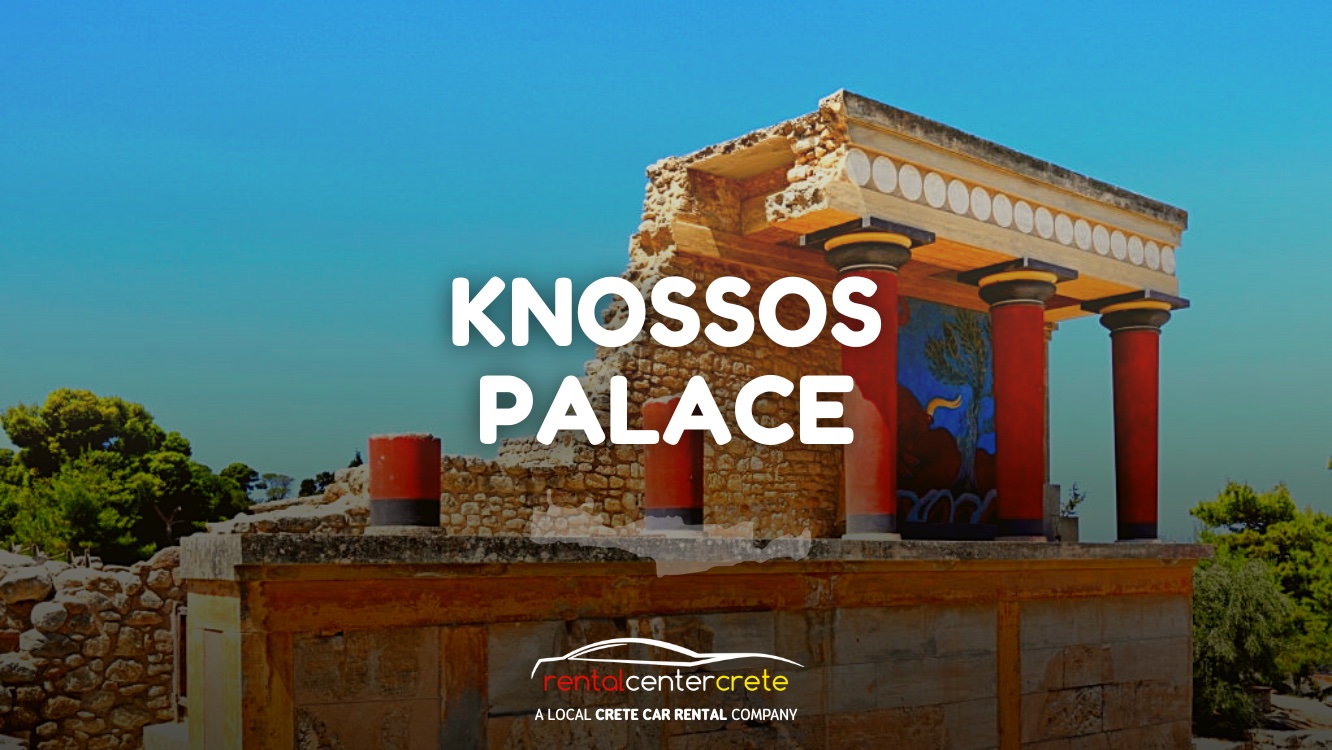
The biggest and most populated of the Greek islands, Crete, is where Knossos Palace is situated. It is perched atop Kephala Hill, which provides a commanding vantage point for taking in the surrounding scenery. The Mediterranean environment, which is characteristic of Knossos Palace’s location, allowed the Minoan civilisation to engage in maritime trade and cultivate crops. The extensive rebuilding work that began at Knossos during the Middle Minoan period about 1900 BCE led to the construction of the palace complex.
Strong Minoan rulers directed the palace’s development over time, each era leaving its stamp on the design and style of the building. A network of hallways connected the various rooms, chambers, and courtyards that made up Knossos Palace. It served as the center of the prosperous and advanced Minoan civilization. However, the palace was destroyed by a natural disaster or a foreign power’s invasion and conquest in 1450 BCE.
Sir Arthur Evans conducted extensive excavations that revealed the ruins and reignited interest in the area for historical and archaeological study early in the 20th century. Knossos Palace draws visitors from all over the world as one of Greece’s most important archaeological sites today.
The Mediterranean climate typical of the area defines the geographical location of Knossos Palace. It has warm, dry summers and mild, rainy winters. The terrain of the island of Crete is very varied, with craggy mountains, lush valleys, and breathtaking shorelines.
Knossos Palace’s location on the island of Crete was significant for a number of reasons. It gave the Minoan civilisation access to essential Mediterranean trade channels, enabling it to engage in maritime trade and forge links with other prehistoric societies. The Minoans were able to grow products like wheat, barley, olives, and grapes due to the rich fields that surrounded Knossos Palace.
The pleasant climate and abundant natural resources of the island, along with Knossos Palace’s strategic location, helped the Minoan civilisation flourish and advance culturally. The history and significance of Knossos Palace within the larger ancient world were significantly shaped by its geographical setting.
The Knossos Palace excavations have produced a wide variety of items that offer priceless insights into Minoan culture. They include ceramics, frescoes, statues, jewellery, tools, and religious relics, to name a few. The intriguing “Bull-Leaping” fresco, which shows acrobats leaping over a bull’s back, and the enduring “Snake Goddess” figurines, which show a female figure grasping snakes, are two of the most well-known discoveries.
These objects provide insightful glimpses into Minoan art, religion, social mores, and the daily lives of those who lived in the palace, in addition to being magnificent pieces of art. They provide a substantial contribution to the comprehension of Minoan society and its cultural norms.
Those people planning to visit the island’s beautiful scenery and historic landmarks have a wide range of options. There are numerous automobile rental firms operating in Crete’s major airports, cities, and tourist spots, both domestic and foreign. There are a number of options, including reputable companies like Rental Center Crete and Justrentals.
It is important to make a rental car reservation in advance which is particularly during the busiest travel times to guarantee availability and lock in affordable pricing. Travellers must have a current domestic driver’s licence or an international driving authorization. It is necessary to get familiar with the local traffic laws and ordinances for a safe and enjoyable driving experience.
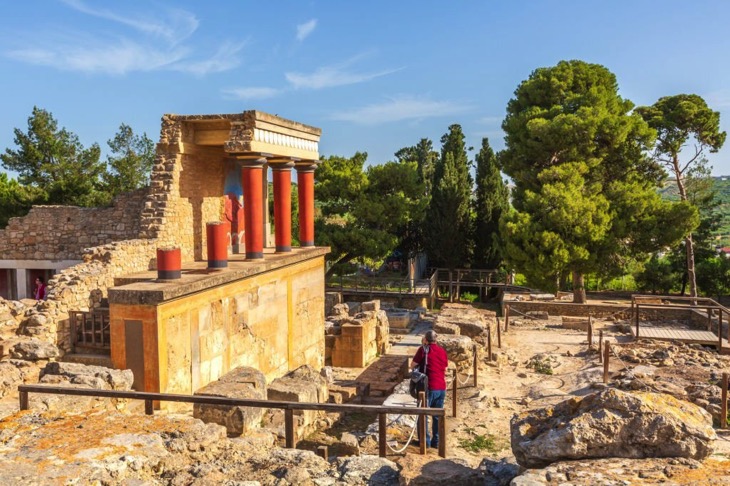
What is Knossos Palace?
The Greek island of Crete is home to the historic archaeological site known as Knossos Palace. It is recognized as the biggest Bronze Age archaeological monument on Crete and one of the most significant and well-preserved Minoan palaces. The Palace of Knossos is a huge representation of Minoan civilization because of its construction, use of fine materials, architectural design, sophisticated construction methods, and astounding size.
The political and ceremonial hub of Minoan society was the Palace of Knossos. It appears to be a confusing arrangement of offices, residences, and storage areas located near a central plaza. Restorations of the palace’s indoor and outdoor paintings, as well as the artistic patterns of the pottery and the insignia on the seals, give an approximative graphic perspective of various aspects of Cretan life in the Bronze Age.
The majority of the features that are currently visible are from the latest known habitational period, which Evans called the Late Minoan. The palace is laid out in an intriguing way, albeit subsequent alterations have obscured the original design. The palace connects the rooms by corridors of varied widths and directions, in contrast to other contemporaneous palaces that united the 1,300 rooms via a number of main passageways. The palace is 6 acres, 24,000 m2, and comprises an auditorium. It has a prominent entrance on each of its four cardinal faces, and sizable storerooms, known as magazines.
Large clay jars known as “pithoi” are found inside the storerooms and contain oil, grains, dried fish, beans, and olives. The palace, which housed grain mills, oil presses, and wine presses, was where a lot of the commodities were processed. Stone storage holes beneath the pithoi were used to keep more priceless items, such as gold. The palace employed cutting-edge architectural methods, for example, a portion of it was five stories high.
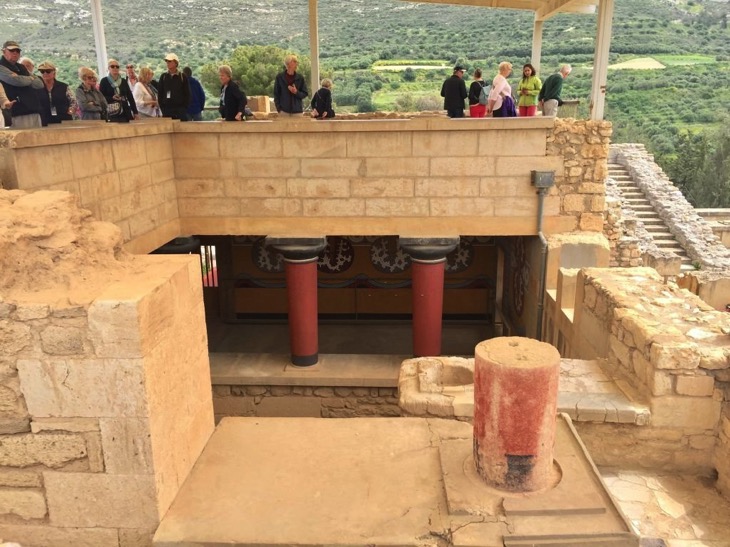
Where is Knossos Palace located?
The biggest and most populated of the Greek islands is Crete, where Knossos is located. The complex was eventually built around a raised central court on top of Kephala. The old buildings were levelled and demolished to create room for the court. The court is oblong in shape with a long axis that commonly refers to “north” and points north-northeast. The long axis of the court is generally depicted on plot designs as horizontal, vertical, or perhaps east-west with the north on the right.
The sea at the Port of Heraklion is located around 5 kilometres, 3.1 mi, to the north of the palace complex. Vlychia Stream is an east-west tributary of the north-south Kairatos and is located directly to the south. The island of Crete is situated in the southern Aegean Sea, about 160 kilometres, 99 miles, south of the Greek mainland, with coordinates of 35°17′53″N and 25°9′47″E.
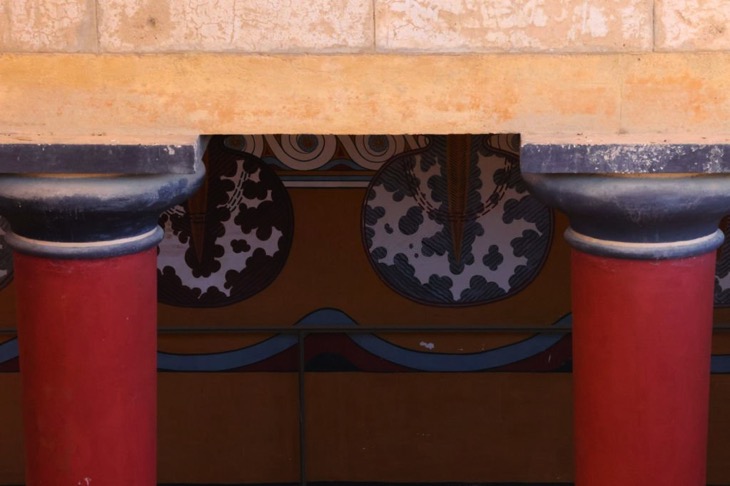
What does Knossos Palace look like?
The spacious design of Knossos Palace immediately draws attention. The palace consists of a maze-like network of chambers, courtyards, and passageways that is dispersed over a huge area. Its architecture stands out for its unusual blend of majesty and minimalism. Beautiful frescoes and bright murals that represent scenes from Minoan life, religious ceremonies, and legendary animals surround the palace. These vibrant artworks provide a look into the Minoans’ artistic prowess, even though they have partially faded with the passage of time.
Visitors come across a number of spaces as they tour the palace, each with a distinct function. Its raised platform and restored reproduction of the well-known “Throne of King Minos,” which is thought to have been the seat of Minoan sovereignty, and the Throne Room stand out. A sense of openness is created by the Central Court, a sizable open space that connects different areas of the palace. The significance of social gatherings and rites in Minoan civilization is reflected in the structure’s sheer scale.
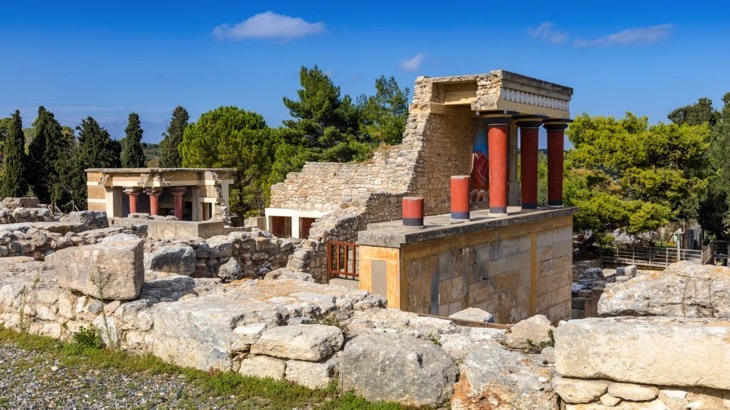
Guests find more private spaces, including living quarters, closets, museums, and workshops, as they go deeper inside the palace. The Minoans paid close attention to comfort and aesthetics, which is evident in their dwelling quarters, which include painted walls, intricate plumbing systems, and courtyards with lots of natural light. These features demonstrate the Minoans’ high level of civilization as well as their admiration for beauty and practicality.
Visitors are able to see the remains of a large city that previously coexisted with the majestic buildings around the palace. More information on the daily life of the Minoans and the urban environment they lived in is easily gathered from the ruins of homes, streets, and public structures.
What is the history of Knossos Palace?
The Neolithic era, roughly 7000 BCE, marks the beginning of Knossos Palace’s history as the location of the first settlement. Knossos Palace achieved its pinnacle as the political, economic, and cultural hub of the Minoan civilization during the Bronze Age.
The earliest palace buildings were built at Knossos around 2000 BCE. These early palaces were small and simple in terms of their architecture. The demand for a more sophisticated and opulent palace emerged as the Minoan culture expanded. The palace complex that is known today was built at Knossos as a consequence of a huge renovation project that started there during the Middle Minoan period, about 1900 BCE.
Powerful Minoan kings oversaw the palace’s expansion and renovation over time, with each age making its mark on the structure’s plan and architectural style. The palace was built using cutting-edge technical methods, including multi-story structures, complex drainage systems, and thoughtfully organised courtyards and hallways.
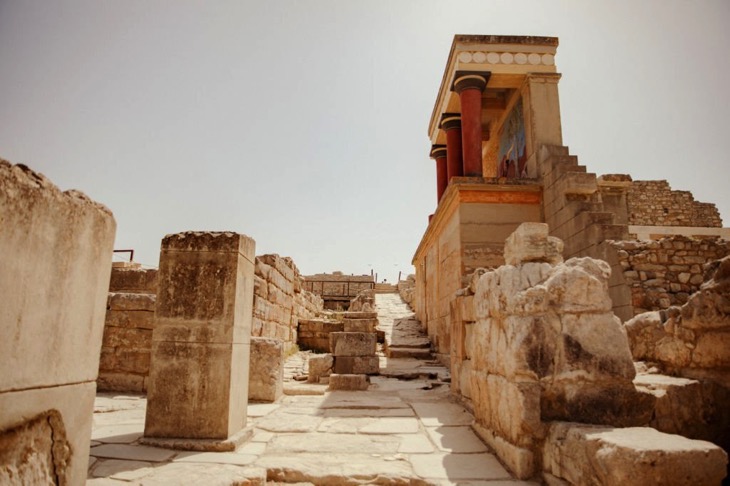
A labyrinthine layout with a number of rooms, chambers, and courtyards connected by a maze of corridors was present throughout the palace complex, which had a large footprint of about 20,000 square metres. A few were using these areas as administrative offices, storage areas, workshops, living quarters, and places of worship.
The 17th and 16th centuries BCE saw the height of the Minoan civilisation, which was centered on Knossos Palace. The Minoans were well-known for their complex culture, seafaring trade, and artistic accomplishments. The palace at Knossos came to represent the prosperity and sophistication of the Minoan people.
The Minoan palaces of Crete, including Knossos Palace underwent a precipitous fall and collapse around 1450 BCE. Historians and archaeologists continue to disagree about the precise reason for its downturn. Some ideas predict invasion and conquest by foreign powers and others contend that natural disasters like earthquakes and volcanic eruptions had a role. Knossos Palace was never fully restored after the catastrophe. The location was soon abandoned, and as time went by, it was gradually covered in dirt and debris and forgotten.
The first person to conduct excavations at the ancient site of Knossos was Minos Kalokairinos. Minos was the first to find the position of the palace of the Minoan kings, known as the Knossos Labyrinth. Arthur Evans later carried on the explorations. The first excavations on the Kephala Hill started in 1877, followed by larger-scale excavations in 1878 that provided the first concrete proof that Knossos or Cnossos, the epicentre of the Minoan civilisation and existed there igniting curiosity across the globe.
The Turkish authorities in charge of the island ordered Minos to stop the excavations three weeks later, but not before Minos found storage chambers and a small portion of the throne hall in the west wing of the palace. Many archaeologists including W.J. Stillman were interested when they heard about the excavations. Sir Arthur John Evans and Heinrich Schlieman were able to excavate the entire palace after the island earned its freedom from Turkey.
The renowned British archaeologist Sir Arthur Evans carried out major excavations at Knossos in the early 20th century, uncovering the ruins of the Minoan palace and reviving interest in the location for historical and archaeological study. The magnificence and complexity of the palace were made clear by Evans’ work as well as the extensive aesthetic and cultural legacy of the Minoan culture.
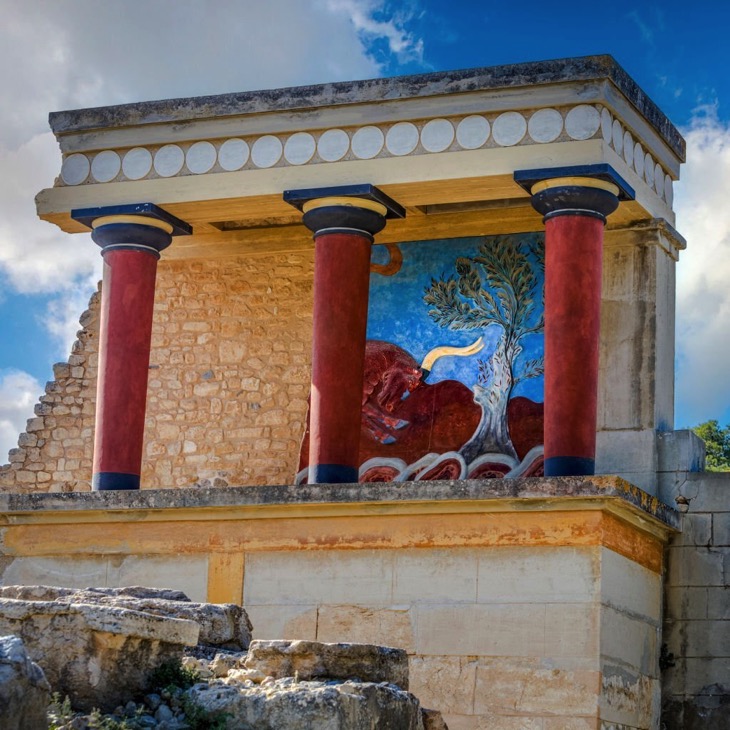
One of the most significant archaeological sites in Greece today is Knossos Palace. It draws tourists from all over the world who come to behold its magnificent antiquity and discover the intriguing history of Minoan culture. We continue to learn more about the Bronze Age Aegean world and its contributions to human history. Knossos Palace was added to the list of UNESCO World Heritage Sites in 1980.
The designation of Knossos Palace as a World Heritage Site highlights both its exceptional worth on a global scale and its importance to the history, culture, and architectural heritage of mankind. The inscription recognizes Knossos Palace’s significance as a significant archaeological site that offers important insights into the Minoan civilisation and its influence on the growth of European culture.
How was the Knossos Palace built?
Knossos Palace was built around 1900 BC. Greek mythology holds that the renowned architect Daedalus created the Minoan palace with such complexity that no one who entered was able to locate their way out. Daedalus has been hailed as the greatest Greek inventor. Daedalus was a true craftsman as well as an artist. ‘Daedalus’ derives from the ancient Greek verb “daedalo.” which means to “work with art”. Daedalus invented the Minoan Crete Labyrinth, the thread of Ariadne, the wooden cow of Pasiphae, the harpoon of Ariadne, the bow of the ships of the time, and the ability to fly on wax wings.
Bronze Age architects accomplished a great achievement of creativity when they built Knossos Palace. The Minoans, a highly developed culture that lived on the island of Crete, constructed the palace. A number of crucial components went into the construction process. Large stone blocks were first used to build a strong foundation that holds the weight of the structures above. The Minoans built a strong foundation for their palace system because of their engineering prowess.
The ashlar masonry method was used to build the walls of Knossos Palace. The stone blocks had to be precisely cut and fitted before being stacked and layered to create the walls. The Minoans used limestone, a typical local resource. The stone blocks were precisely cut and fitted together to form a sturdy and long-lasting wall without using mortar.
The other essential structure is timber. The higher levels of the palace were supported by wooden beams and columns, which provided structural stability. The Minoans obtained the required lumber from the plentiful forests in Crete.
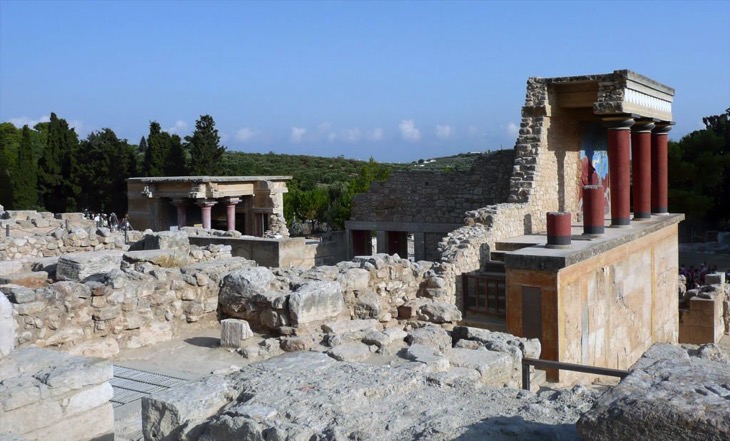
The Knossos Palace had a complex and winding architectural layout. The palace had many floors, connecting rooms, courtyards, and passageways. The layout was created to support a variety of uses, including offices for administration, storage, workshops, residences, and ceremonial areas.
The development of cutting-edge infrastructure was another aspect of the construction process. An extensive drainage system was constructed in order to ensure effective water management throughout the royal complex. Water was gathered and distributed via wells, cisterns, and clay pipes, demonstrating the Minoans’ engineering prowess.
The palace’s decoration served as the final construction step. The walls and ceilings were embellished with vivid frescoes, dexterous wall paintings, and decorative accents. These decorative elements displayed the sophisticated artistic abilities of the Minoans and gave insight into the vibrant religious and cultural lives of the palace’s occupants.
The building of Knossos Palace was evidence of the Minoans’ mastery of architecture and efficiency. The spectacular palace complex they created as a consequence of their inventive methods, careful craftsmanship, and attention to detail served as a tribute to the accomplishments of their civilisation.
What are the artefacts kept inside the Knossos Palace?
Listed below are the artefacts kept inside the Knossos Palace.
- Frescoes: The palace at Knossos was painted red ochre and decorated with full-color fresco panel murals and scenes of people, animals, plants, legendary beings, and sea life.
- Pottery: Evans developed a chronology of Knossos’ pottery to compare it to similar pottery from other parts of the eastern Mediterranean.
- Sculptures: Small miniatures and larger statues of legendary beings, deities, and human figures are brought to life by sculptures. The Minoans’ complex works of art demonstrate their mastery of carving and capacity for producing lifelike depictions. They provide information about Minoan cultural behaviours, religious beliefs, and artistic expressions.
- Jewellery: The Minoans were masters of metalworking and valued personal decoration, and jewellery is another notable category of artefacts that demonstrates it. Finely created gold and silver objects encrusted with shells, jewels, and enamel are on display for admiration. The Minoans’ sense of fashion, as well as their trading links and access to valuable materials, are reflected in their necklaces, bracelets, earrings, and rings.
- Tools and Weapons: Knossos Palace’s collection of tools and weaponry provides insight into Minoan society, revealing their defensive prowess and military structure.
- Seals: The iconography, commercial networks, and religious symbolism of the Minoans are revealed through the seals from Knossos Palace.
- Linear A Tablets: The Linear A tablets from Knossos Palace reveal details about the Minoan way of writing, trade, and social structure, even though the meaning of the script is unclear.
1. Frescoes
Fresco is a technique for painting murals by applying water-based paint directly to wet plaster so that the colour becomes a permanent component of the plaster. The Knossos Palace was a vibrant place, as were classical Greek buildings and modern Greek structures. The walls and pavements in the Early Minoan Period were painted a light crimson made of red ochre. The walls have full crimson fresco panel murals on them in addition to the backdrop colour. White and black were added in the Middle Minoan Period that followed, then blue, green, and yellow as the art evolved.
These frescoes make the visitors awe at the vivid hues and minute details of the ancient Minoan artworks, offering a remarkable view into the past’s artistic accomplishments. The colours were created using natural resources like ground hematite. Indoor panels were painted on new, pure plaster that was softer than the plaster with additives typically used on walls, while outdoor panels were painted on freshly applied stucco with the motif in relief.
The decorative themes were typically bordered scenes, including people, mythical beings, animals, plants, and sea life. the earliest replicas of clay patterns. The majority have been rebuilt using different quantities of flakes that have fallen to the ground. Evans employed a variety of technicians, including restorers, chemists, and artists, to work on the project. Reconstruction was made feasible by the symmetry and utilisation of templates beyond what was justified by the flakes alone.
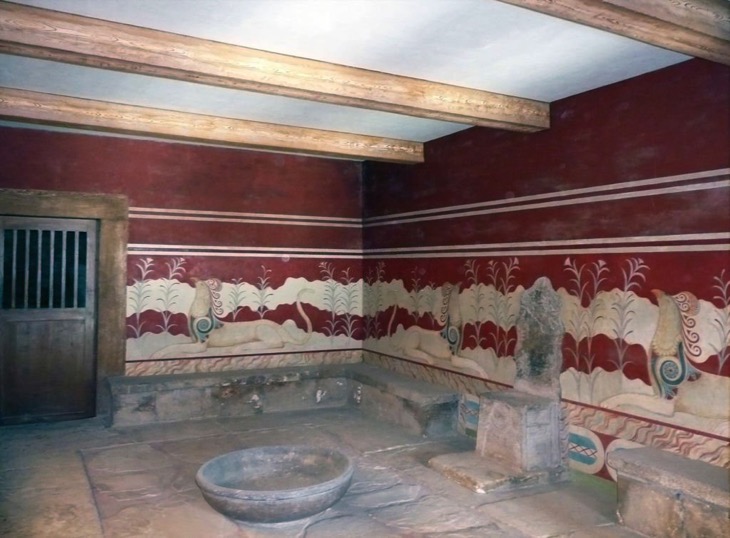
The theme has been taken from the template obtained elsewhere if there is limited evidence of the employment of a certain template in one location. Some conventions were utilised in Egyptian tomb art to help in prediction which are similar to modern-day murals. Some archaeologists have argued that Evans and the restorers produced a modern artefact based on modern architecture and art rather than discovering the palace and civilisation as they were
The application of the buon fresco technique in the preservation of frescoes is an essential component that contributes to their maintenance. The Minoan artists painted wet plaster with pigments, letting the colours soak in and become a permanent part of the wall surface while the plaster cured. The pigments were guaranteed to adhere to the plaster by using the “true fresco” method, creating a sturdy and long-lasting piece of art. The pigments were unable to peel or flake off because they sank into the surface.
2. Pottery
The pottery of Knossos is abundant, lavishly adorned, and specially fashioned for the time. Evans developed a larger chronology by comparing it to similar pottery from other parts of the eastern Mediterranean because of it, a challenging to successfully challenge. The scope of the project and the challenges that the archaeologists and workers had to face prevented precise records of the locations of some artefacts from being retained, which was a drawback.
The history of Crete is filled with evidence of numerous potter styles and production methods. Early Minoan ceramics were distinguished by designs with spirals, triangles, curved lines, crosses, fish bones, beak spouts, and terracotta sculptures. There are significant variations in how these techniques are reproduced across the island, even though there are many Early Minoan aesthetic motifs that are comparable, which reflect a range of changes in power structures and tastes.
Naturalistic patterns, including fish, squid, birds, and lilies were popular during the Middle Minoan period. Flowers and animals were still recognizable in the Late Minoan period, although there was a greater variety. Paintings of human figures are incredibly uncommon and paintings of land mammals weren’t widespread until later times, as opposed to later Ancient Greek vase painting. They were discovered around 1900.
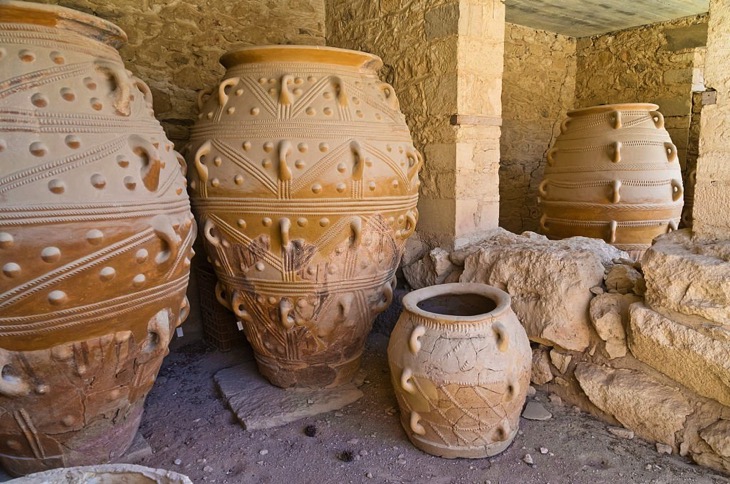
They gave experts and visitors invaluable insights into the Minoan culture and established a concrete link to the past through the examination and exhibition of the pottery.
The pottery at Knossos Palace was preserved in large part due to burial practices. The palace’s ruins were shielded from the elements over a period of centuries by layers of debris, dirt, and collapsed buildings. The pottery was protected from direct sunshine, dampness, and physical harm by being buried. The steady temperature and humidity levels that were beneficial to the preservation of the pottery were a result of the underground environment.
3. Sculptures
The beautiful statues at Knossos Palace are renowned for giving an insight into the Minoans’ artistic skill. The site contains sculptures of different sizes, from little figurines to monumental statues. Deities, legendary creatures, and human figures are all shown in these artworks. The exquisite intricacies and realistic portrayals in the sculptures demonstrate their high level of craftsmanship. They often use naturalistic proportions with an emphasis on smooth, flowing lines. These sculptures offer important insights into the Minoan civilization’s social mores, religious practices, and artistic traditions.
Massive stone sculptures from the Minoan period are quite uncommon compared to mainland civilizations today and later Ancient Greek art. There are smaller sculptures and some “evidence for the existence of large wooden and even metal statues in Crete,” which have been acrolithic and vividly painted, so it is partially explained by the absence of suitable stone.
Small sculptures of various forms were extremely skillfully crafted. Stone vases, which were often lavishly adorned in relief or by cutting, were a kind manufactured in Egypt and the Greek mainland before the Bronze Age. They started to appear in Crete from the Early Minoan II period onward, typically in funeral or palace contexts. Many have been made specifically to serve as burial goods. Rhyta are the most ornate palace vases which were likely used for libations.
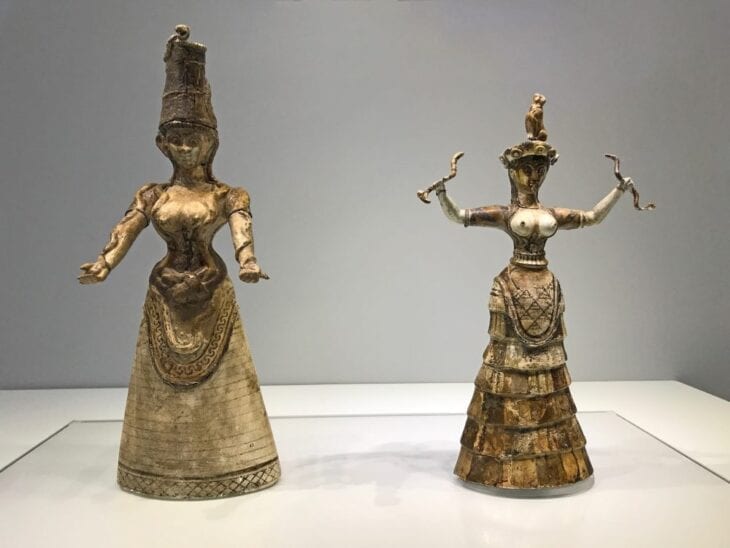
Some of them are formed into sculptures like animal heads or seashells, while others have geometric patterns or figurative images etched onto the sides. Most of them are too big and heavy to be used comfortably throughout a feast, and many include holes at the bottom for pouring libations. Most commonly used are semi precious or soft stones like steatite or serpentine. A number of these are of particular interest to archaeologists because they depict relatively detailed scenes from Minoan life that are seen on tiny seals.
One of the reasons sculptures are important is that they enable great works of art to endure through the ages, offering perceptions into the creative accomplishments and cultural heritage of the Minoan culture.
The sculptures discovered at Knossos Palace have been preserved in large part because of archaeological conservation efforts. Archaeologists meticulously excavated the artworks using specialist equipment and methods to reduce damage. The current conservation techniques were used to carefully record, catalogue, and rebuild the fragments in order to stabilise and repair sculptural fragments. The conservators use techniques that include cleaning, strengthening weak areas, and applying protective coatings to prevent future deterioration.
4. Jewellery
The jewellery-making prowess of the Minoans was well-known, and Knossos Palace produced a treasure trove of beautiful decorations. A variety of gold and silver jewellery with diamonds, shells, and vibrant enamel has been found at the site. The delicate technical prowess and great aesthetic sense of the Minoans are on full display in their necklaces, bracelets, earrings, and rings. These priceless ornaments reveal the Minoans’ love of personal ornamentation and their trade relationships with other cultures.
They started to appear around 1900. The majority of Minoan jewellery has been found in graves, and up until more recent times, most of it was diadems and hair decorations for women. However, there are many thin pieces that were sewn onto garments and the usual forms of rings, bracelets, armlets, and necklaces. Gold is often hammered very thin and was the primary material in earlier ages, but it later appeared to grow scarce.
The Minoans used imported copper and gold to produce intricate craftsmanship. Jewellery such as labrys pins, bracelets, and hair ornaments are depicted. The Malia necklace, a gold necklace with bees on a honeycomb, serves as evidence that the Minoans were experts at granulation. The 19th-century thieves of a royal burial ground they called the “Golden Tomb” overlooked it.
The importance of jewellery is that it gives visitors a chance to see and admire them, providing information on the design, artistry, and cultural value of jewellery in Minoan society.
Jewellery preservation has benefited from archaeological conservation initiatives. Jewellery objects are carefully uncovered and handled during excavations to prevent damage. Fragments or broken pieces are carefully documented, catalogued, and rebuilt using cutting-edge conservation methods and supplies. The preservation techniques like cleaning, strengthening vulnerable areas, and putting protective coatings are used to maintain the jewellery’s lifespan.
5. Tools and Weapons
The extensive collection of tools and weaponry found at Knossos Palace provides information about the practical aspects of Minoan society. A variety of items, including farming tools, loom weights, kitchen utensils, and pottery-making equipment, have been discovered during excavations. These artefacts provide insight into the Minoans’ household life, textile industry, and agricultural methods.
A variety of weapons, including swords, spears, and daggers, have been made public by the palace. These weapons reveal the Minoans’ defensive prowess and military structure, providing insight into their interactions with surrounding civilizations.
Cretan archaeologists have discovered finely decorated bronze weapons, particularly from the Late Minoan period. Numerous durable materials, including stone, metal, and bone, were used to make the tools and weapons discovered at Knossos Palace. Stone tools such as axes, blades, and grinding stones were frequently made from resilient hard rocks like flint or obsidian.
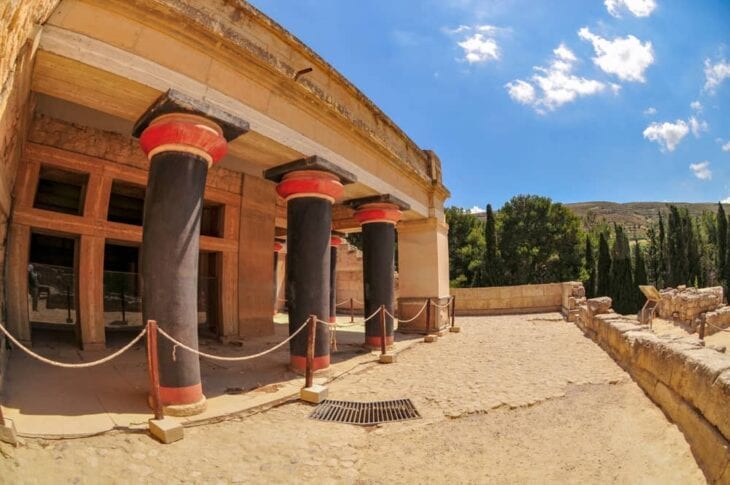
The tools and weapons were of the greatest importance since they served utilitarian, commercial, and symbolic purposes in Knossos Palace. They contributed significantly to the development of Minoan society, the economy, and the military, and they shed light on the civilization’s technological advancements, social structures, and cultural values.
The durability of the materials employed, the protective burial circumstances, and the diligent efforts of archaeologists and conservators all contributed to the preservation of tools and weapons in Knossos Palace. These forces worked together to ensure the survival of these relics, which now shed light on the tools, technologies, and weapons used by the Minoan civilization.
6. Seals
The Minoans were widely known for using seals, and they did so for administrative, commercial, and even religious purposes. Numerous seals made of faience, stone, and other materials have been discovered in Knossos Palace. These seals frequently feature fine engravings of animals, people, and abstract patterns. Documents, containers, and other goods were marked and authenticated using them. The seals shed light on Minoan commerce networks, religious symbolism, and iconography.
Minoan seals are small, “pocket-size”, and shaped like personal amulets. A large percentage of them are nail sizes that are similar to those of human fingernails, notably those of the little finger. They are able to be compared to the 1-inch, 3 cm, scaraboid seals from Ancient Egypt that were occasionally imitated in Crete. The greatest instances of Minoan seals measure several inches. Minoan seals are the most prevalent surviving form of Minoan art after pottery, numbering several thousand from the Early Minoan II period on, in addition to over a thousand impressions, few of which match existing seals.
The Minoan civilisation made impression seals in the shape of carved jewels and comparable objects in metal, ivory, and other materials. They play a significant role in Minoan art. They were employed for document and object identification.
Durable materials like stone, clay, or metal were frequently used to create the seals that were discovered in Knossos Palace. These materials are able to endure the test of time and are resistant to degradation. Stone seals that have been cut from substances like steatite or hematite are especially hardy. Clay seals made from baked clay are more resistant to deterioration because of their firm surface. Metal seals are corrosion-resistant whether they are formed of bronze or another metal.
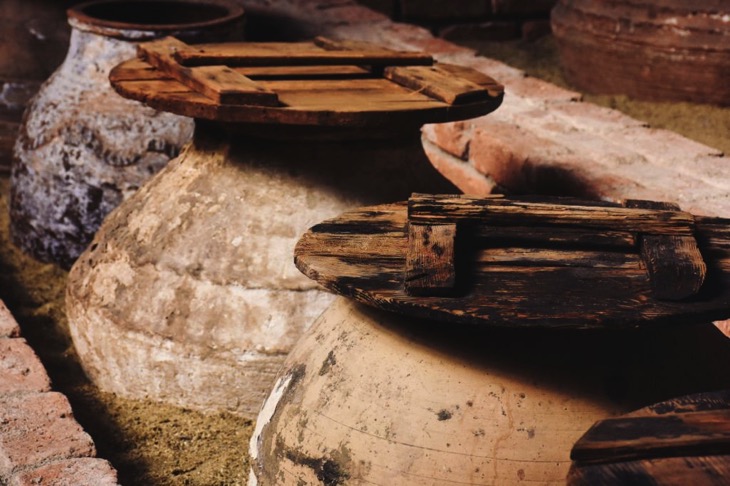
Seals at Knossos Palace were preserved in large part through burial practices. The palace’s remains were gradually buried by piles of dirt, wreckage, and fallen buildings. The seals were shielded from deterioration-causing elements like direct sunlight, moisture, and temperature changes by being buried. The seals were preserved for a long period of time due to part of the controlled humidity levels and steady climate that the burial site offered.
7. Linear A tablets
The Linear A tablets from Knossos Palace, written in an unreadable script, are one of the most fascinating finds there. These clay tablets feature symbols that resemble hieroglyphs and are thought to have been used for communication and record-keeping. The tablets reveal details about the Minoan way of writing, trade, and social structure. The Linear A tablets contain the key to solving additional puzzles about Minoan society and its language, even though the meaning of the script is still obscure.
The examination of various signs and brief inscriptions discovered on Crete and mainland Greece led English archaeologist Sir Arthur Evans to produce a paper titled “Cretan pictographs and the prae-Phoenician script” in the late 19th century CE. An archive of clay tablets was discovered at the Knossos excavation site in 1901 CE, which is typical of many clay tablet archives discovered in the Near East. The scripts that were written on the tablets that Evans found were all distinctive from the writings that had previously been discovered.
The Linear tablets discovered in Knossos Palace are important for comprehending the governmental, economic, and cultural facets of Minoan culture. They are essential for reconstructing and comprehending Minoan society’s complex tapestry and its contributions to ancient history and culture.
The conservation of Linear A tablets is largely dependent on archaeological work. The tablets are carefully uncovered and handled during excavations to prevent damage. Tablet fragments or shattered pieces are scrupulously recorded, categorized, and, to the extent feasible, reassembled. The longevity of the tablets and prevention of further deterioration is able to be achieved by using preservation techniques such as cleaning, stabilization, and consolidation.
What were Knossos Palace’s primary effects on Minoan art?
Listed below are the Knossos Palace’s primary effects on Minoan art.
- Innovation in pottery: The creation of Minoan pottery was influenced by Knossos Palace, with its elaborate patterns, vivid colors, and expert craftsmanship.
- Advancements in sculpture: The architectural features of Knossos Palace served as models and inspiration for Minoan sculpture, displaying their mastery of proportion, form, and naturalistic expression.
- Development of frescoes: The frescoes of Knossos Palace established the bar for Minoan art, encouraging other artists to produce their own wall paintings.
- Religious influence: The religious significance in Minoan society was reflected in the religious effect of Knossos Palace on creative representations.
- Technological advancements: The quality and range of the artistic works produced during the Minoan period were influenced by the technological achievements that Knossos Palace helped bring about.
1. Innovation in pottery
The Minoans were skilled potters, and the pottery produced at Knossos Palace was renowned for its intricate designs and vibrant colours. The palace’s workshops were responsible for developing new pottery shapes and designs, and the use of advanced techniques, such as the use of a potter’s wheel, which allowed for the creation of more complex designs.
Minoan pottery underwent significant invention and improvement due to a large part of Knossos Palace. The pottery pots made in the palace’s workshops came in a variety of shapes, designs, and patterns. The pottery at Knossos Palace displayed the artistic ingenuity and technical competence of the Minoans with its intricate designs, vivid colours, and fine craftsmanship. The influence of the palace resulted in the introduction of novel vessel forms and artistic designs, as well as improvements in pottery production methods like wheel throwing.
2. Advancements in sculpture
The Minoan sculpture was developed to some extent at Knossos Palace. The columns, capitals, and relief embellishments of the palace served as models for sculptures and sources of inspiration. A mastery of form, proportion, and realistic representation are seen in the sculptures from Knossos Palace. They frequently portrayed human beings, animals, and mythological creatures with attention to detail and a feeling of movement. The large-scale sculptures and more minutely detailed smaller pieces of art were influenced by the palace.
3. Development of frescoes
The palace was decorated with colourful frescoes depicting scenes from Minoan life, such as bull-leaping, dancing, and religious ceremonies. The frescoes found at Knossos Palace were notable for their use of colour and detail, and helped to establish the Minoans as skilled artists.
The exquisite frescoes of Knossos Palace were famous and had a big influence on Minoan art. Colourful and detailed frescoes that represented a variety of subjects, such as scenes from daily life, religious rites, natural phenomena, and mythology, covered the palace’s walls and ceilings. The frescoes from Knossos Palace showed improvements in composition, colour scheme, and painting methods. They established a standard for Minoan frescoes and encouraged painters all around the Minoan culture to produce their own wall artwork.
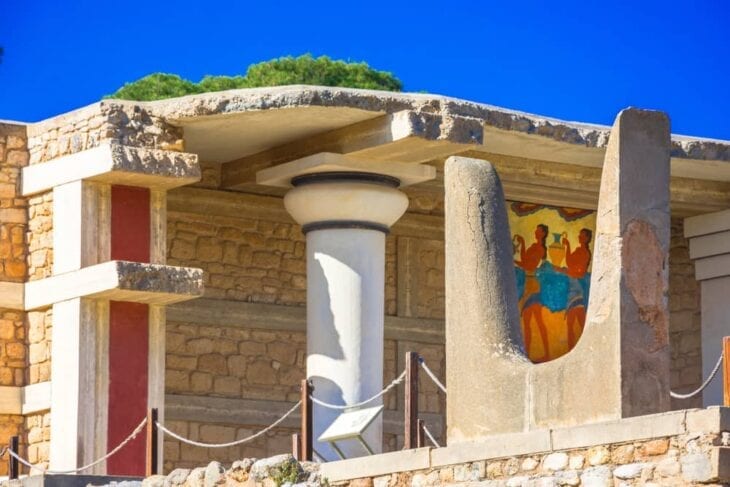
4. Religious influence
The Minoan religious arts were greatly influenced by Knossos Palace. The palace’s pivotal position in religious and ceremonial activities influenced how deities, holy ceremonies, and symbols were portrayed in Minoan art. Religious themes were frequently evident in the frescoes and artefacts from the palace, including bull-leaping scenes, goddess depictions, and sacred symbols related to fertility and nature. The religious influence of Knossos Palace has been seen in the creative creations of the Minoans, which reflects the significance of religion in Minoan civilization.
5. Technological advancements
Advances in technology that had an effect on Minoan art were made feasible by Knossos Palace. Innovative methods for making ceramics, working with metal, and creating fine art were created in the palace’s workshops and by its craftspeople. The calibre and variety of their creative productions improved as a result of their experiments with novel materials, tools, and firing techniques. These scientific and technological developments influenced creative practices not particularly in the palace but in other Minoan cities, advancing Minoan art as a whole.
What methods were used to excavate The Palace of Knossos?
The methods used in the excavation of the Palace of Knossos required careful planning and a variety of procedures and techniques. The excavations at Knossos were started and directed by British archaeologist Sir Arthur Evans using some excavation techniques in the early 20th century.
First, Sir Arthur Evans used a stratigraphic method and meticulously removed each layer of soil and debris one at a time. Arthur Evans was able to carefully expose the site’s various architectural layers and structures. Evans was able to determine the chronological evolution of the palace and its many stages of the building by recording and examining the layers in order.
Second, Evans was dedicated to conserving and recreating the palace’s architectural elements. The archaeologist meticulously recorded the positions of damaged or collapsed walls and columns and then carefully rebuilt them from the original materials whenever they came across them. The palace was intended to be brought back to its previous beauty and serve as a visual depiction of Minoan architecture.
Third, Evans separated the site into distinct portions or zones and concentrated on excavating each one separately. The procedure made it feasible to examine each area’s buildings, rooms, and objects in more detail. Evans thought that the method helped to clarify the arrangement of the palace’s rooms and their purposes.
Fourth, there were uncovered during the Knossos excavation such as numerous frescoes, pieces of pottery, sculptures, and other artefacts. Evans took a lot of time to protect these delicate objects. They carefully recorded the location, state, and context of any frescoes they came across before removing them from the walls for restoration and display. The objects were catalogued, investigated, and put on display to shed light on Minoan art, culture, and daily life.
Fifth, Evans carried out considerable repair and restoration work at Knossos in addition to excavation. Historians have argued and criticised them in regard to their accuracy and authenticity even though the purpose of these reconstructions was to give tourists a sense of the grandeur of the palace.
Lastly, the structures, architectural elements, and relics were thoroughly documented throughout the excavation process with precise sketches, measurements, and photographs. The documentation was crucial for further investigation, interpretation, and publication of the results. Evans released many volumes that included extensive documentation of their excavations and outlined the findings, hypotheses, and interpretations of the Knossos and Minoan sites.
How much does an admission ticket cost in Knossos Palace?
Adults must pay €15 for general entry as of 2023, while €8 is the price for discounted admission.
Free admission is given to children under the age of five. EU citizens under 25 and students are permitted free access. Combined admission to Knossos and the Heraklion Archaeological Museum costs €20. It is good for three days following the chosen booking date.
What time periods does Knossos Palace operate?
The Knossos Palace complex is open every day during summer, beginning from 8 a.m. to 7 p.m. The palace closes at 5 o’clock in winter as of 2023. Knossos prohibits tourists on a few holidays such as March 25, Easter, May 1, Christmas, and New Year’s Day.
It is recommended to check the official website or get in touch with the Knossos Palace visitor center directly for the most up-to-date and accurate information on the opening times during the anticipated visit.
How to Go to the Palace of Knossos?
Listed below are ways to go to the Palace of Knossos.
- First, visitors are able to drive to the Palace of Knossos via car. It is a convenient choice if one has access to a car. The palace is around 5 kilometres southeast of Heraklion’s downtown. Knossos is to be reached by following the signs, and the trip takes around 15 minutes. Visitors are able to park close to the site in a designated area.
- Second, visitors are able to use bus line 2 to get to Knossos from either the city center or the main bus station, referred to as “KTEL”. The Palace of Knossos is accessible by Heraklion’s well-connected public bus system. The trip takes about 20 minutes, and buses operate regularly. The bus timetable must be checked in advance because it changes depending on the season.
- Third, taxis are commonly available in Heraklion and visitors are able to hire one to transport them to the Palace of Knossos easily. Taxis provide the convenience of a direct trip, and it typically takes 15 minutes to travel from the city center to Knossos. It is advised to confirm the fare with the taxi driver prior to beginning the trip.
- Lastly, taking a guided trip that includes transportation to Knossos is another choice. The Palace of Knossos is the centrepiece of many guided excursions offered by tour companies in Crete. These tours often come with transportation, admission tickets, and the expertise of a skilled guide who shares insights and background knowledge about the location.
Do you need to rent a car to visit Knossos Palace?
No, a car rental is not required in order to explore Knossos Palace. There are other transportation available that are able to take you to the site such as public buses, taxis, and joining a tour. Renting a vehicle is practical and flexible, particularly if visitors want to explore other parts of Crete on their own time. However, it comes down to their particular preferences and travel schedule. They are able to visit Knossos Palace without looking for a car rental in Crete if they prefer guided tours or feel comfortable using public transportation.
What are the factors to consider before renting a car in Crete?
Listed below are factors to consider before renting a car in Crete.
- Insurance: Insurance protection must be considered prior to renting a car. Rental companies normally offer minimal insurance, however, there are options for more comprehensive protection, including theft protection and collision damage waiver. It is advisable to assess the insurance options and determine whether any additional protection is necessary for specific demands.
- Driver’s Age: Car rental companies frequently impose minimum age requirements. The legal car rental driving age in Crete varies from 21, depending on the rental agency. There are additional charges for drivers who are under or over a certain age.
- Driver’s Gender: Car rental companies usually don’t consider the gender of the vehicle. The main considerations are the driver’s age, ability to drive, and possession of a valid driver’s licence.
- Car Type: Guests must think about what kind of car best suits their requirements. Rental companies offer a range of vehicles for rent, including compact cars, sedans, SUVs, vans, and more. Take into consideration the number of passengers, luggage capacity, and comfort needs when selecting the appropriate car.
- Documents Needed for Renting a Car: Visitors often need a valid driver’s licence, international driver’s licence, or EU driver’s licence, a passport or ID card, and a valid credit or debit card in order to hire a car in Crete. It is recommended to find out in advance what the demands of the particular business are given that certain rental agencies have additional documentation requirements on how to choose the right car to rent in Crete.
How much does a car rental in Crete cost?
A car rental in Crete typically costs between €30 and €40 per day. An average week’s car rental costs €250. A car rental costs around €78 for the duration of a weekend. These prices change based on the kind of car one plans to rent. Car rental firms offer a wide variety of vehicles depending on the requirements of their customers. The cost of car hire in Crete is based on a number of elements, such as the length of the rental, the kind of vehicle, the rental agency, the season, and any extra services or extras visitors decide to add. It is essential to remember that costs fluctuate, thus it is advised to check with several rental firms or online marketplaces for the most recent prices.
It is important to keep in mind that additional gasoline costs and optional equipment like GPS or kid seats, might be necessary. Different insurance alternatives such as basic coverage or supplementary comprehensive insurance with a lower excess/deductible are often provided by rental businesses. It is advised to compare prices, explore several rental providers, and read the rental agreement’s terms and conditions. Checking online travel agencies and local car rental websites is helpful for locating cheap rates and making reservations in advance.
Are cameras allowed inside the Knossos Palace?
Yes, cameras are allowed within Knossos Palace. Visitors are allowed to carry cameras and snap pictures while on the property in order to document the beauty and historical significance of the location. However, it is important to keep in mind that using tripods or other professional photographic gear requires additional permits or expenses.
Are kids allowed inside the Knossos Palace?
Yes, kids are allowed within Knossos Palace. Visitors of all ages, including children and families, are welcome on the site. Children are able to learn about ancient history and archaeology while having fun at Knossos Palace, which is an interesting and informative site. Young children must be under adult supervision to protect their safety and to avoid any unintentional damage to the site or its artefacts. There are fun places in Crete to take your kids so it is important to watch children and lead them through the site because some portions of the palace have uneven ground or steps.
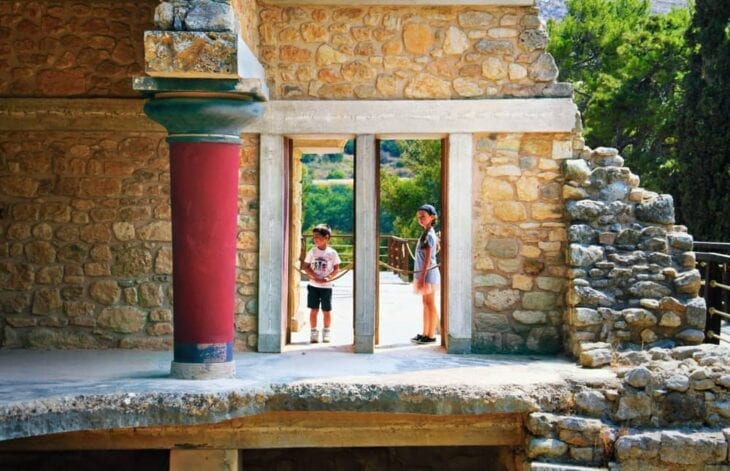
Last updated on August 13th, 2023















